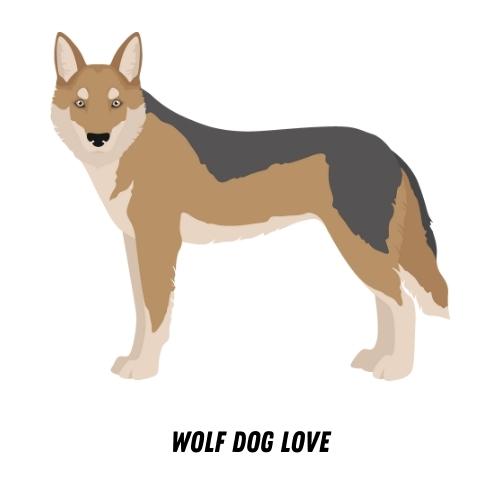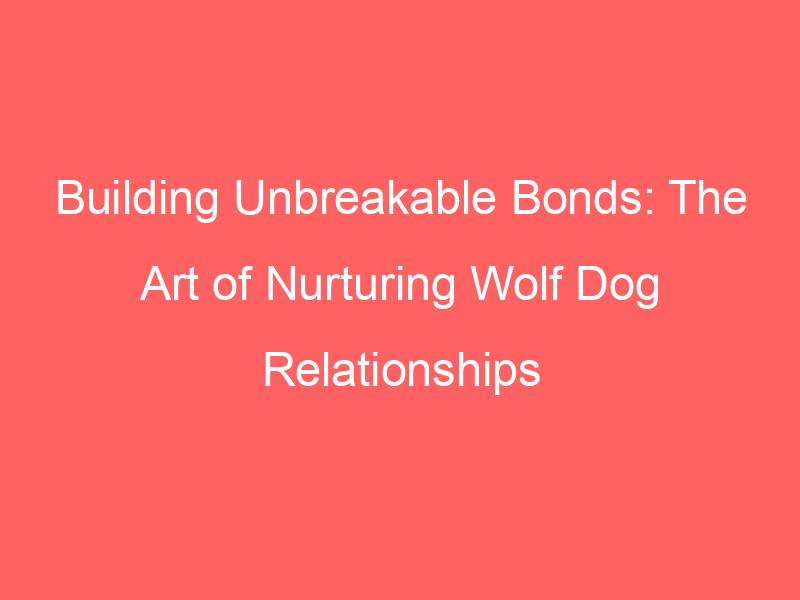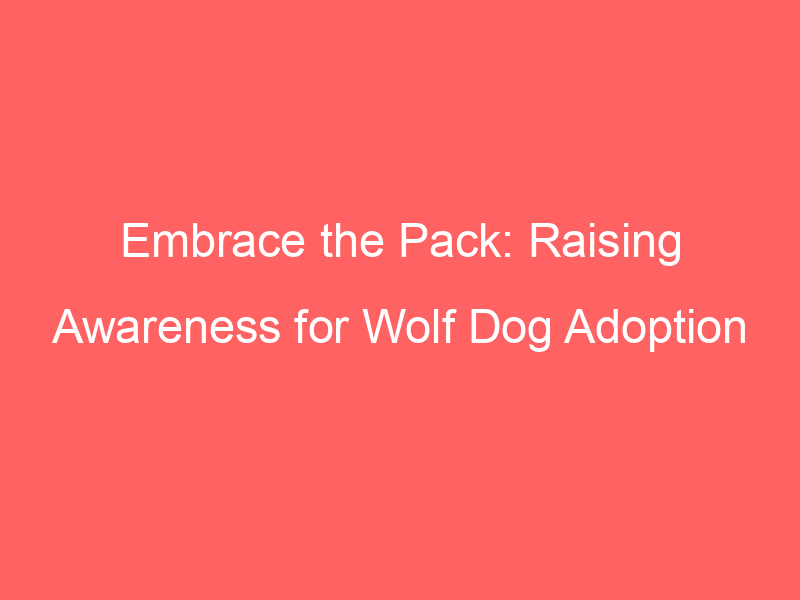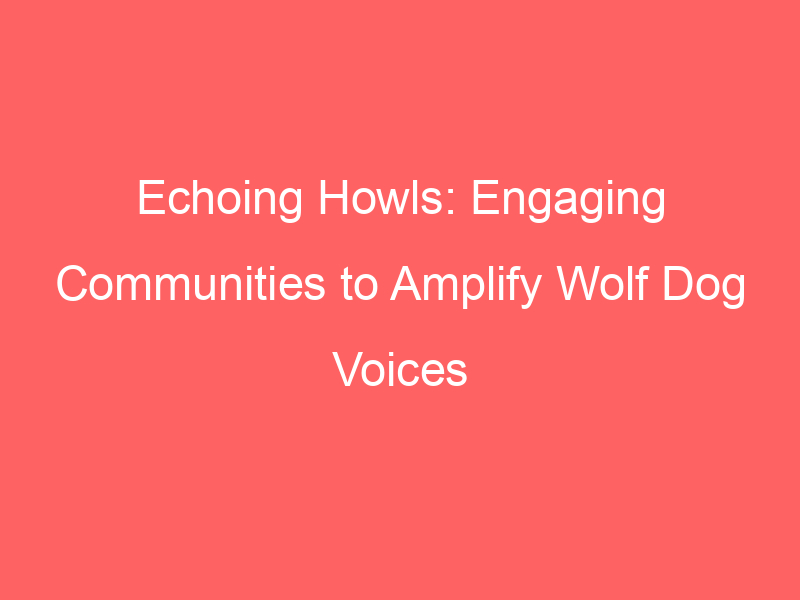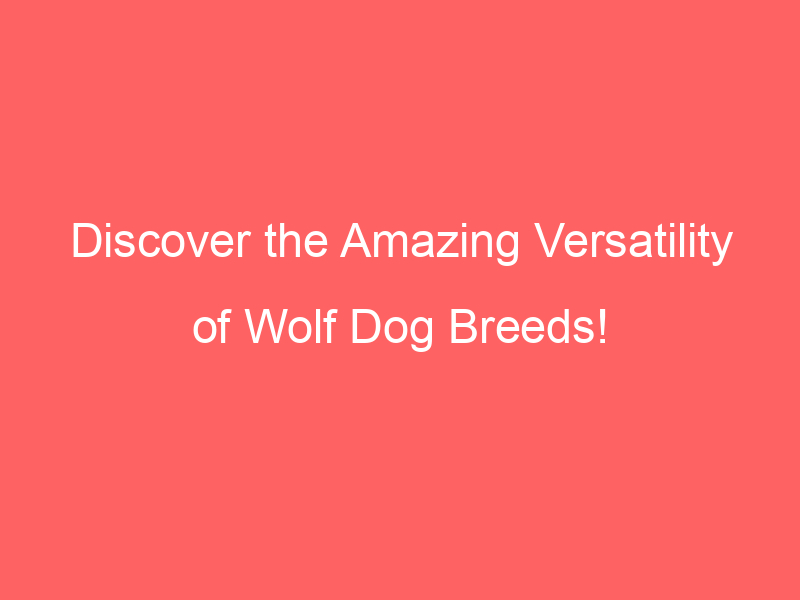Introduction to Wolf Dog Relationships
Wolf dogs are unique creatures that combine the wild instincts of wolves with the domesticated nature of dogs. This blend creates a special bond between wolf dogs and their human companions. However, understanding and nurturing these relationships is crucial for the well-being of both parties.
- Understanding the Unique Nature of Wolf Dog Bonds
- The Importance of Nurturing these Relationships
Wolf dogs are not your average pets. They possess a unique blend of characteristics that make their bonds with humans unlike any other. These bonds are formed based on mutual respect and understanding. Wolf dogs are highly intelligent and require mental stimulation, which can be provided through interaction with their human companions. They are also pack animals, which means they thrive in a family environment where they feel like they belong.
Nurturing a relationship with a wolf dog is not just about providing food and shelter. It’s about understanding their needs, respecting their instincts, and creating an environment where they can thrive. This requires time, patience, and a lot of love. Nurturing these relationships is important because it helps to ensure the happiness and well-being of the wolf dog. It also strengthens the bond between the wolf dog and its human companion, leading to a more fulfilling relationship for both.
In conclusion, wolf dog relationships are unique and require a special kind of understanding and nurturing. By taking the time to understand these creatures and their needs, and by providing them with the love and care they require, we can form strong, meaningful bonds with them.
Building Bonds with Wolf Dogs: A Comprehensive Guide
Building a bond with a Wolf Dog is a rewarding experience, but it requires understanding, patience, and a safe environment. Here, we will explore the first step in building this bond: establishing trust.
Establishing Trust: The First Step in Building Bonds
Trust is the cornerstone of any relationship, and it’s no different with Wolf Dogs. There are three key aspects to focus on when establishing trust with your Wolf Dog.
- Understanding Wolf Dog Behavior
- Creating a Safe and Comfortable Environment
- Consistent and Patient Interaction
Wolf Dogs are unique creatures with behaviors that are a blend of their wolf and dog heritage. Understanding these behaviors is the first step in building trust. For instance, Wolf Dogs are pack animals and value hierarchy. They also communicate through body language, vocalizations, and scent marking. By understanding these behaviors, you can better anticipate their needs and reactions, which is crucial in establishing trust.
Wolf Dogs need a safe and comfortable environment to feel secure. This includes providing them with a suitable living space, proper nutrition, and regular veterinary care. Additionally, they should have access to toys and activities that stimulate their minds and bodies. A Wolf Dog that feels safe and comfortable is more likely to trust its human companions.
Consistency and patience are key when interacting with your Wolf Dog. This means maintaining a regular routine, being consistent with your commands and responses, and showing patience during training sessions. Remember, trust is not built overnight. It takes time and consistent, positive interactions to establish a strong bond with your Wolf Dog.
In conclusion, understanding your Wolf Dog’s behavior, creating a safe and comfortable environment, and consistently interacting with them in a patient manner are crucial steps in establishing trust. This trust is the foundation upon which a strong bond with your Wolf Dog can be built.
Wolf Dog Training: A Crucial Aspect of Relationship Building
Training your Wolf Dog is not just about teaching them commands. It’s a crucial part of building a strong, healthy relationship with your canine companion. Let’s delve into the importance of training and some effective techniques to use.
- Importance of training in strengthening Wolf Dog relationships
- Effective training techniques for Wolf Dogs
Training is a two-way communication process. It helps you understand your Wolf Dog’s needs and behaviors while teaching them to understand and respond to your commands. This mutual understanding fosters trust and respect, strengthening your bond.
Training also provides mental stimulation for your Wolf Dog. These intelligent animals need challenges to keep their minds sharp. Training sessions can provide this mental workout, keeping them engaged and happy.
Moreover, training is essential for safety. A well-trained Wolf Dog is less likely to engage in risky behaviors, ensuring their safety and the safety of others.
Wolf Dogs are intelligent and independent, requiring specific training techniques. Here are a few methods that have proven effective:
| Training Technique | Description |
|---|---|
| Positive Reinforcement | This technique involves rewarding good behavior, which encourages the dog to repeat it. Rewards can be treats, toys, or praise. |
| Consistency | Consistency in commands and rewards is crucial. Changing commands or being inconsistent with rewards can confuse your Wolf Dog and hinder training progress. |
| Patience | Training takes time. It’s important to be patient and not rush the process. Celebrate small victories and keep sessions short and fun to avoid frustration. |
| Socialization | Exposing your Wolf Dog to different environments, people, and animals can help them become more adaptable and well-behaved. |
Remember, every Wolf Dog is unique. What works for one may not work for another. It’s important to be patient, consistent, and flexible in your approach.
Nurturing Wolf Dog Bonds: Techniques and Strategies
Building a strong bond with a Wolf Dog requires understanding and communication. This section will explore the importance of communication in nurturing Wolf Dog bonds and provide strategies for effective interaction.
Communication: Key to Understanding Wolf Dog Bonds
Communication is the cornerstone of any relationship, and it’s no different with Wolf Dogs. By learning their language and responding effectively, you can foster a deep, meaningful bond with your Wolf Dog.
- Learning the language of Wolf Dogs
- Responding effectively to Wolf Dog communication
Wolf Dogs communicate primarily through body language, vocalizations, and scent marking. Understanding these signals can help you better understand your Wolf Dog’s needs and emotions. For instance, a wagging tail often signifies happiness, while flattened ears might indicate fear or aggression.
Once you understand your Wolf Dog’s language, it’s crucial to respond effectively. This means acknowledging their signals and reacting appropriately. If your Wolf Dog shows signs of fear, for example, it’s important to provide comfort and reassurance. On the other hand, if they display signs of aggression, it’s necessary to establish boundaries and assert your role as the pack leader.
Remember, communication is a two-way street. Just as you learn to understand your Wolf Dog’s signals, they too will learn to understand yours. Over time, this mutual understanding can lead to a strong, nurturing bond between you and your Wolf Dog.
Physical Interaction: Enhancing Wolf Dog Relationships
Physical interaction plays a crucial role in nurturing bonds with Wolf Dogs. It is a powerful tool that helps to establish trust, respect, and mutual understanding between you and your Wolf Dog. Let’s delve into the aspects of physical interaction that can enhance your relationship with your Wolf Dog.
- The role of play in Wolf Dog bonding
- Appropriate physical contact with Wolf Dogs
Play is an essential part of a Wolf Dog’s life. It is not just about fun and games; it is a way for them to learn, socialize, and bond with their human companions. Engaging in play activities with your Wolf Dog can significantly strengthen your bond. It helps to build trust, stimulate their minds, and provide them with the physical exercise they need.
Try to incorporate various types of play, such as fetch, tug of war, or hide and seek. Remember, the goal is not to win but to have fun and interact with your Wolf Dog. Always end the play session on a positive note, with your Wolf Dog wanting more. This will ensure that they associate playtime with positive experiences, further strengthening your bond.
Physical contact is another vital aspect of bonding with your Wolf Dog. However, it’s important to understand that not all Wolf Dogs appreciate the same type of physical contact. Some may enjoy belly rubs, while others prefer a gentle stroke on the head or back. It’s crucial to observe your Wolf Dog’s reactions to different types of touch and respect their preferences.
Never force physical contact, especially if your Wolf Dog seems uncomfortable. Instead, let them come to you when they feel ready. This patience and respect for their boundaries can significantly enhance your bond and build trust. Remember, building a relationship with a Wolf Dog is a journey, not a destination. It requires time, patience, and understanding.
In conclusion, physical interaction, through play and appropriate touch, is a powerful tool for enhancing your relationship with your Wolf Dog. It helps to build trust, stimulate their minds, and provide them with the physical exercise they need. Always respect your Wolf Dog’s boundaries and preferences, and remember that building a bond is a journey that requires time, patience, and understanding.
Case Studies: Successful Wolf Dog Relationship Building
Let’s explore some real-life examples of successful wolf dog relationship building. These case studies will provide you with practical insights and strategies that have been proven to work.
-
Case Study 1: Building Trust with a Rescued Wolf Dog
Meet Max, a rescued wolf dog who was initially fearful and distrusting of humans. His new owner, Sarah, knew that building a strong bond with Max would require patience and understanding.
She started by giving Max his own space and allowing him to become comfortable in his new environment. She would sit near him, talking softly and offering treats. Over time, Max began to associate Sarah with positive experiences and his trust in her grew.
After several weeks, Max allowed Sarah to pet him. This was a major milestone in their relationship. It showed that Max was beginning to trust Sarah and see her as a friend, not a threat.
Today, Max is a happy and well-adjusted member of Sarah’s family. His story is a testament to the power of patience, understanding, and positive reinforcement in building a strong bond with a wolf dog.
-
Case Study 2: Training a Wolf Dog for Better Bonding
Next, let’s look at the story of Luna, a wolf dog who was trained to strengthen her bond with her owner, John. John knew that training would not only improve Luna’s behavior but also deepen their relationship.
John began by teaching Luna basic commands like “sit”, “stay”, and “come”. He used positive reinforcement, rewarding Luna with treats and praise whenever she followed a command. This not only helped Luna learn the commands but also associated following John’s instructions with positive experiences.
Over time, Luna became more obedient and responsive to John’s commands. More importantly, their bond grew stronger. Luna began to see John as her leader and trusted friend, and John felt a deeper connection with Luna.
John’s experience with Luna shows that training can be a powerful tool for building a strong bond with a wolf dog. It requires consistency, patience, and positive reinforcement, but the rewards are well worth the effort.
These case studies show that building a successful relationship with a wolf dog is possible with patience, understanding, and positive reinforcement. Whether you’re rescuing a wolf dog or training one, the key is to build trust and create positive experiences.
Conclusion: The Rewards of Nurturing Wolf Dog Bonds
As we reach the end of our journey exploring the world of Wolf Dog relationships, it’s important to reflect on the rewards that come from nurturing these unique bonds. These rewards are not just for the Wolf Dogs themselves, but also for the humans who share their lives with them.
- The emotional benefits of a strong Wolf Dog relationship
- How nurturing Wolf Dog bonds can improve their overall behavior
Forming a strong bond with a Wolf Dog can bring immense emotional benefits. These animals, known for their loyalty and affection, can provide companionship and comfort. They can help reduce feelings of loneliness and anxiety, and can even boost your mood. In fact, a study conducted by the American Pet Products Association found that pet owners reported lower levels of stress and depression than non-pet owners.
Nurturing a bond with a Wolf Dog can also lead to improvements in their behavior. Wolf Dogs that feel secure and loved are less likely to display aggressive or destructive behaviors. They are more likely to listen to commands and be cooperative. This is backed by a study from the Journal of Veterinary Behavior, which found that dogs with strong bonds to their owners were more responsive to training and had fewer behavioral problems.
In conclusion, the rewards of nurturing a bond with a Wolf Dog are plentiful and profound. From emotional benefits for both the human and the Wolf Dog, to improvements in the Wolf Dog’s behavior, the effort invested in building this relationship is well worth it.
Remember, every Wolf Dog is unique and requires a personalized approach to bond-building. By understanding their needs and showing them love and respect, you can cultivate a strong, rewarding relationship that will last a lifetime.
| Benefits of Nurturing Wolf Dog Bonds |
|---|
| Emotional benefits for humans and Wolf Dogs |
| Improvements in Wolf Dog behavior |
| Stronger, more rewarding relationships |
